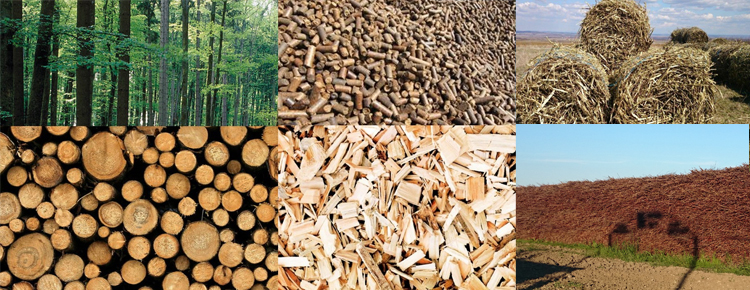
For a long time, people have tried to store solar heat for cold winter nights. Trees rule this principle, since the beginning of time. During incineration, their wood releases the stored solar energy.
Green plants are fixing (retaining) the solar energy by chemical transformation processes from solar light, water, minerals in the soil and CO2. This transformation occurs in the main by photosynthesis in green leaves (Chlorophyll). Initially, plants produce a sugar (glucose, also called dextrose) and then a “higher” sugar (polysaccharide), these are bigger carbon compounds (like cellulose). These represent the main components of biomass. People and animals also produce biomass by food intake.
Bioenergy sources exist in a variety of different forms. Among the fuels, there are:
- Wood and waste wood from forest thinning, forest management and felling, from sawmills or from recycled wood.
- Energy wood, i.e. specially cultivated, fast growing tree species like poplar and willow tree (also known as “short rotation trees.”)
- Agricultural residues (straw.)
- Specially cultivated energy crops on the set-aside areas.
Important liquid energy sources that, for instance, can serve as fuel:
- Plants containing sugar and starch for the transformation in ethanol.
- Oil-bearing plants like Rape and Sunflowers for the production of vegetable oil.
Gaseous energy sources to be mentioned:
- Biogas, which is composed from agricultural residues by microbial transformation (i.e. fermentation.)
The oldest and most well known procedure is the incineration of mainly carbon, fixed in the biomass and combines with the oxygen in the air. This chemical reaction releases heat.
The biomass incineration is CO2-neutral, but, as biomass results not only from pure carbon, but with each incineration, other substances are released.
Biomass can be chemically transformed: for instance, into wood gas with which motors such as the internal combustion engine can be propelled.
Advantages and disadvantages of using biomass
If biomass is being energetically used, the carbon circuit remains closed to a large extent. CO2 fixed in biomass is being released again when used energetically. The almost closed CO2 circuit does not additionally affect the greenhouse effect.
- The huge “hunger for energy” of the highly developed companies ends in a few decades, the fossil resources formed by millions of years. The one`s who energetically uses biomass, treats with care these reduced valuable fossil reserves.
- Transport and storage of biomass implies considerably more reduced risks than that used by fossil energy sources. You may think of leaking natural gas pipelines, damaged oil tankers or cracked oil pipelines.
- The energy balance of biomass is positive. The energy used for the production of energy sources is less than that released when using them energetically. For wood chips one spends less than 5 % of useful energy for their production.
- Renewable raw materials generally originate from the region, so long transportation means are being avoided.

 Română
Română Deutsch
Deutsch